Recent Articles
Popular Makes
Body Types
2012 Hyundai Veloster First Drive Review

People laughed when Hyundai entered the U.S. market back in 1985 with its $4,995 Excel. That laughter diminished a bit when nearly 170,000 of them sold the first year. Then, two years later, when it turned out what the Hyundai really excelled at was embodying the literal equivalent of the old FORD acronym (Found On the Road Dead) the laughter resumed.
Undaunted, Hyundai soldiered on, gradually improving styling, quality, reliability and, lately, designing its own engines and transmissions, too. Then, when the bottom fell out of the economy a few years ago, the only car company still managing a smile, actually no, make that outright laughter, was Hyundai — all the way to the bank.
One of the rare car companies to actually improve its sales position during the merciless morass of miscues passing for economic policy these days, Hyundai finds itself in a rather unique position. Flush with cash and egged on by a legion of loyal new fans, the company can afford to take some risks, think outside the box, do something crazy, like, say, put two doors on one side of a car and just one on the other.
With that, we get Veloster, the name of which is an amalgamation of the words “Velocity” and “Roadster”; neither of which apply to the car actually, but hey — we’re getting ahead of ourselves.
2012 Hyundai Veloster: Pricing and Trim Levels
With pricing starting at $17,300, Hyundai is being very aggressive with its new “reverse halo” car. Veloster is so designated, because rather than sitting at the top of the heap of its model offerings the way most halo cars do, Hyundai has positioned Veloster near the bottom of its lineup.
The Hyundai’s base price is predicated upon which transmission choice you opt for. That $17,300 (plus a $760 destination charge) gets you a six-speed manual transmission equipped Veloster. For $18,550 (plus the aforementioned $760) you can be one of the first people to buy a Hyundai equipped with company’s own six-speed dual clutch transmission. Designed and manufactured in-house, it is the equivalent of the direct-shift gearboxes so many high performance manufacturers tout these days.
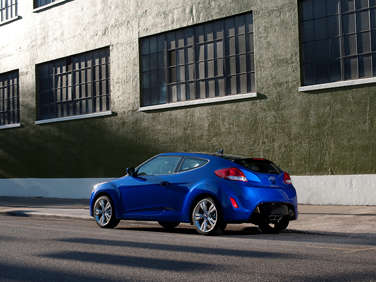
2012 Hyundai Veloster: Competition
In its own words, Hyundai lists Honda CR-Z, MINI Cooper and Scion tC as Veloster’s natural enemies. To its credit, the Hyundai has more horsepower, except for the Scion, and is lighter than all but the MINI Cooper.
Without getting too much into the performance of the Hyundai, anybody really serious about being entertained by the dynamics of their auto over all other concerns, will probably go back to the MINI dealer after driving all the others on this list. Dynamically, the second choice would be the Honda. In our opinion, even though the Scion has more power than the Veloster, handling-wise it’s in a dead heat with the Hyundai.
When it comes to content though, as you’ll see in the interior, as well as the packages and options section of this report, the Veloster is going to be really tough for the others to beat.
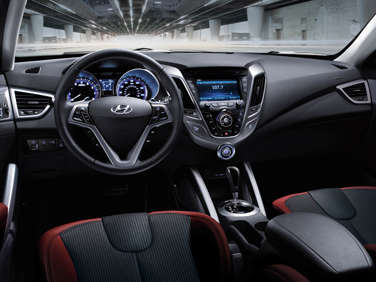
2012 Hyundai Veloster: Exterior
Without question the single most intriguing aspect of the Hyundai Veloster is its styling. The car simply looks like nothing else out there — and in a good way. Those exaggerated wheel arches, the body-colored door handles and rear-view mirrors, the way the roof looks like a motorcycle helmet, the hunkered down profile; the Veloster is, quite literally, an attractive car. People stop, stare and openly ask questions about it.
If you’re the sort of person who doesn’t like talking to strangers, you might want to wait a year or two before buying a Veloster. When people see it for the first time, they get very inquisitive. And, when they see that third door open, their jaws drop and they circle back to the other side of the car to see how they could possibly have missed the back door on that side (which, of course, isn’t there). Much of this is due to the way the handle for the third door is hidden from view. The car looks like a two-door coupe on both sides — until the third door opens.
Other nice touches include the available 18-inch wheels with body-colored inserts, the dual centered chrome exhaust tips, the hood scoop detailing, and the LED position lamps. All of these together create more than enough visual entertainment to keep the eye suitably arrested for vast amounts of time. Even with all of those details, the design is unified, it flows and is quite tasteful.
This is a car you’ll sit out in your garage and just stare at.
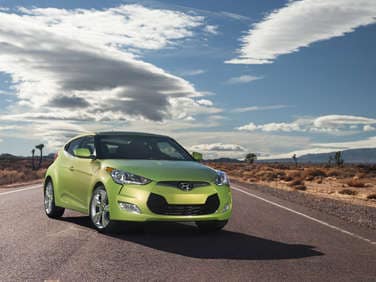
2012 Hyundai Veloster: Interior
The motorcycle helmet theme of the roof is carried over to the interior of the car as well. The center stack is shaped to look like the gas tank on a sport bike, with the start/stop button at the bottom set up to resemble the gas cap. The grab handles on the doors mimic the skeletal structure of a sport bike’s frame and, if you look carefully at the way the dash flows in the picture to the right, the surrounds for the door handles kind of mimic handle bar grips.
The way it all fits together is wholly indicative of the strides Hyundai has made in the craftsmanship of its vehicles. The seams and gaps are tight and the materials have a nice finish. The hard plastic look of so many interiors in this price category isn’t evident here.
The seven-inch monitor in the center stack hosts Pandora Internet radio, and Gracenote is there to help manage your music collection. The monitor will also display the output of a video game console — which can be powered by the 115-volt power outlet in the Veloster. Additionally, Bluetooth is standard equipment and includes voice recognition technology. Hyundai’s Blue Link telematics system is also standard equipment.
Blue Link (similar in function and concept to GM’s OnStar) will provide text messaging, turn-by-turn navigation, and point of interest searches, all by voice. Its Geo Fence feature enables the owner to establish boundaries within which the car can travel. If the Veloster is taken outside of the boundary area, the owner of the Hyundai gets a text message. Blue Link will also help recover the vehicle if it is ever stolen. And yes, if you lock yourself out, Blue Link can help you get back in.
In terms of spaciousness, the Veloster, even though it looks lower and sleeker than all its competitors — save perhaps the Honda — actually has more interior volume than all of them, including the MINI Clubman. The two-seat CR-Z has more cargo space, but other than that, the Hyundai wins the space race.
Additionally, Veloster’s seating is quite comfortable over long distances, its ergonomics are sound, and all of the Hyundai’s controls are both readily decipherable and easy to operate. Its rear seats offer a comfortable place to ride, though headroom is a bit of an issue for people six feet tall or more. For a short ride around town, it wouldn’t be a big deal, but on a very long drive, it’ll get real quiet back there.
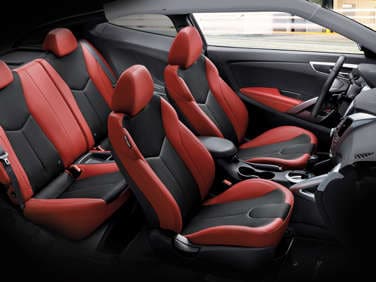
2012 Hyundai Veloster: Packages And Options
Two option packages are offered, Style and Tech; although if you want Tech, you have to have Style (the package we mean, Hyundai’s making no judgments regarding your personal attributes).
They consist of:
Style Package ($2,000):
- 18-inch alloy wheels with P215/40R18 tires
- Chrome grille surround with piano black highlights
- Front fog lightsPanoramic sunroof
- Piano black interior accents
- Dimension premium audio with eight speakers, external amp and subwoofe
- rLeatherette bolster seats and door inserts
- Leather wrapped steering wheel and shift knob
- Alloy pedals
- Driver auto-up window
Tech Package ($2,000):
- Requires Style Package
- Unique 18-inch alloys with painted inserts
- Backup warning sensors
- Navigation system with rearview camera
- Automatic headlights
- Proximity key entry with electronic push button start
- 115-volt outlet
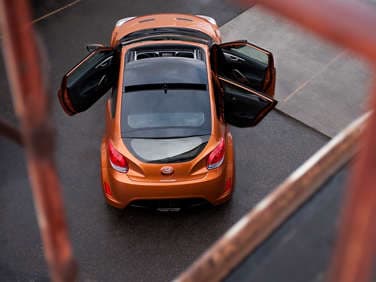
2012 Hyundai Veloster: Powertrain and Fuel Economy
Hyundai’s on a big campaign these days to be a leader in fuel economy. As such, the company is striving to make as many of its products as possible achieve 40 miles per gallon on the highway, in real world situations. In the words of Hyundai’s lead guy here in the U.S., John Krafcik; “ We’re going after 40 mpg, with no asterisks.”
With that in mind, it comes as no surprise the Veloster’s 1.6-liter direct injected engine is a paragon of efficiency over performance. The engine produces 138 horsepower at 6,300 rpm and 123 ft-lbs of torque at 4,850 rpm. And while this is more than enough to set the lightweight Hyundai in motion (the Veloster weighs 2,657 pounds with the dual-clutch six-speed gearbox and 2,584 with the traditional six-speed manual), the way the Veloster goes will never enable it to be taken for a true sports car.
The new dual clutch transmission, as its name implies, uses a pair of clutches operating in synchronization to allow the transmission to perform shifts. In this configuration, two gears are engaged simultaneously, but only one of the clutches is. So, when the car is in first gear, second gear is already engaged, but the clutch for second gear is not. When it’s time to use second gear, its clutch engages and the clutch for first gear releases, enable the transmission to engage third, so when its time to shift to third, the clutch managing second gear releases and is then freed up to manage fourth gear, and so on. This process ensures rapid shifts with minimal loss of forward momentum, is smoother than a traditional automatic, and gets better fuel economy because the power usually sapped by the torque converter a regular automatic transmission uses can be put to work moving the car.
The EPA says the Veloster is good for 28 mpg in the city, 40 on the highway and 32 combined, with its six-speed manual transmission. With the EcoShift dual clutch transmission, the Hyundai returns 29 mpg in the city, 38 on the highway and 32 combined.
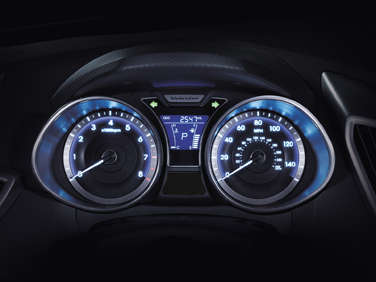
2012 Hyundai Veloster: Driving Impressions
As we mentioned earlier, the Veloster’s name is a combination of the words “Velocity” and “Roadster”. Frankly though, the car in neither a roadster, nor is its capability for velocity exceptional. Still, the 2012 Hyundai Veloster is an absolutely wonderful car around town. It’s smooth, easy to drive, steers and stops well, and its tidy size makes it easy to park.
On the highway, as plagues so many Hyundai products, road noise is an issue. Hyundai has yet to build a truly quiet car — even its flagship Equus is noisier than its competitors. In the Veloster, tire roar is the culprit, and while it is noticeable, it isn’t so raucous as to make it a deal breaker, were we seriously considering the purchase of a Veloster. Fact is, most of the cars in this category are on the loud side.
With the six-speed manual transmission, the engine winds freely, though with only 123 ft-lbs of torque on tap, you do have to be deft with the co-ordination of the gas pedal and clutch pedal to set the car into motion. It can be done smoothly, but you have to manage your torque carefully.
The Hyundai’s steering is responsive, but like so many electric systems, the tactile response is a bit muted. Still, if you pay attention, it keeps you informed. Body roll is discernable in corners, though minimal. And yes, the Veloster can be entertaining to drive on a winding road — just not outright exciting.
All in all, it is what it is; a handsome car with reasonable, if not exhilarating driving dynamics. Honda and MINI have nothing to fear from the Hyundai in this regard. The Scion on the other hand, might want to watch its back, the Veloster’s coming up — fast.
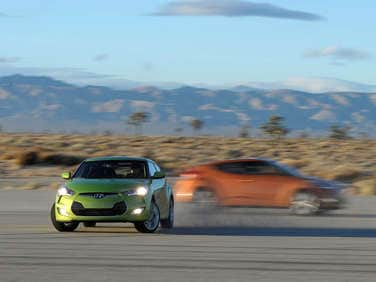
2012 Hyundai Veloster: Safety Equipment
When it comes to safety gear, in addition to its complement of high-strength steel body components, all of the other usual suspects are in on the defensive game with Hyundai’s Veloster.
Among the highlights;
Driver and front passenger advanced airbags, driver and front passenger side-impact airbags, front and rear passenger side air curtains; and four seatbelts, with adjustable front-seat shoulder belt anchors. To protect the kids, Hyundai includes a power window lockout button, a child safety lock for the third door, and the LATCH (Lower Anchors and Upper Tether Anchors) system for child safety seats.
The mechanical compliment of protect-you-from-yourself gear includes, an anti-lock Braking System (ABS) with four-wheel disc brakes, Vehicle Stability Management (VSM), Electronic Stability Control System (ESC) with Traction Control System (TCS), Brake Assist, and a Tire Pressure Monitoring System (TPMS).
To protect you from the bad people out to get you and your Hyundai, the Veloster rocks an anti-theft alarm system integrated with remote keyless entry and panic alert, an engine immobilizer, and all of the anti-theft/vehicle monitoring features of the Blue Link system we told you about earlier.
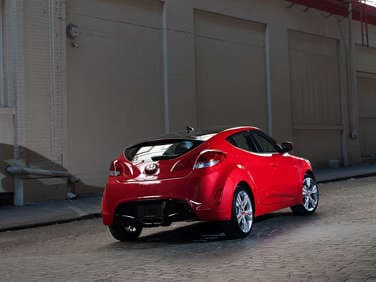
2012 Hyundai Veloster: Summary
With Veloster, Hyundai is once again saying to the rest of the industry it is possible to deliver style on a budget. With its combination of good looks, a strong feature set, and a comfortable and ergonomically correct interior, the Veloster, in many ways, sets new standards in its price class.
Of course, with all that heavy goodness in so many places, there’s bound to be something light somewhere. In this case, it’s in the way the car goes over the road. While the Hyundai is quite competent, when it comes to truly backing up the way it looks with grin inducing ability on twisting tarmac, the Veloster comes up a tad short.
Of course, there’s absolutely nothing wrong with any car more power can’t fix, and this is a case where that is absolutely true. We’re thinking a 2600-pound Veloster propelled by the 274-horsepower mill currently powering Hyundai’s Sonata Turbo would easily live up to the “velocity” half of its name.
Hyundai provided travel, lodging and vehicle for this review.